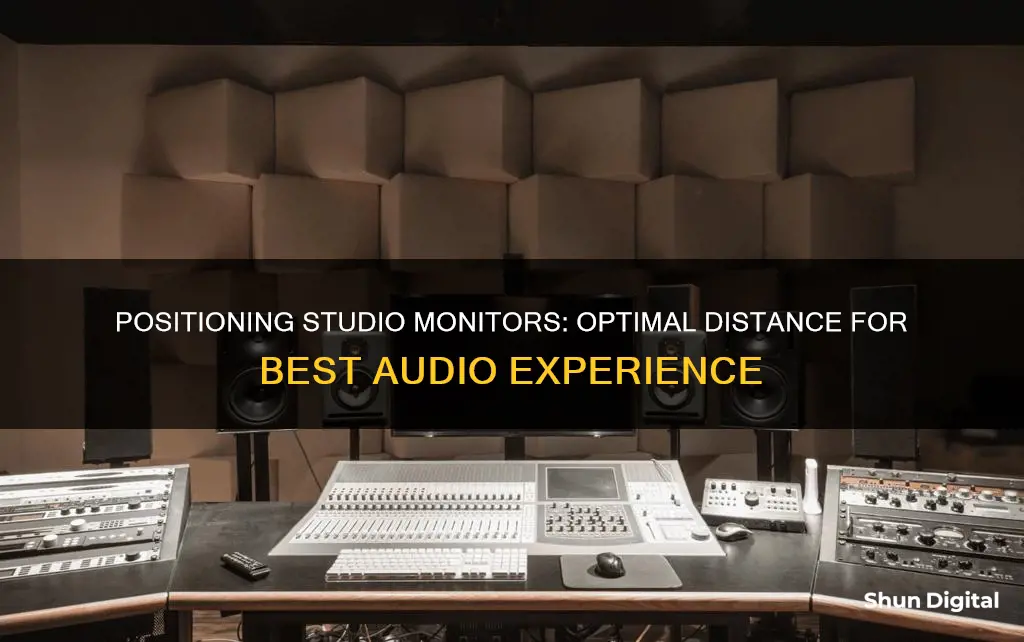
Studio monitor placement is crucial to achieving consistent results from your mixes. The ideal setup is an equilateral triangle, where the distance between the two speakers is the same as the distance from each speaker to your head. This helps create an accurate stereo image and a balanced soundstage, allowing you to accurately judge sounds placed in the centre of the stereo image. It also establishes an optimal sweet spot for monitoring, minimising phase issues and discrepancies in frequency response. The speakers should be placed slightly above ear level, tilted slightly backwards, and isolated from the desk or stands to prevent vibrations. While the ideal distance between the speakers and your head is around 5 to 6 feet, this may vary depending on the size of the room and the specific speakers being used.
| Characteristics | Values |
|---|---|
| Distance between monitors | 4 feet apart (measured from the centre of the speaker cone) |
| Distance between monitors and head | 4 feet from each speaker |
| Distance from wall | Minimum of 6-10 inches away from the wall; 2-3 feet is better |
What You'll Learn

Speakers should be placed in an equilateral triangle with the listener
The placement of your studio monitors in relation to your listening position can greatly affect the quality of sound you experience. The ideal setup is to have your listening position and the two monitors form an equilateral triangle. This means that the distance between the left and right speakers should be the same as the distance from each speaker to the back of your head.
To achieve this setup, you can use a tape measure, a piece of string, or even a guitar cable to measure and adjust the distances between the speakers and your listening position. It is recommended that the speakers are placed slightly higher than your ears and tilted slightly downwards. This ensures that the tweeters are at the same height as your ears when you are seated, which is typically about 47-55 inches (120-140 cm) from the floor.
By creating an equilateral triangle with your speakers and listening position, you will find a natural stereo "sweet spot" that allows you to move around a bit and still experience optimal sound. This setup also ensures that you minimise high frequencies bouncing off the side walls, as the speakers are pointing directly towards your ears.
It is important to note that the size of the equilateral triangle can vary depending on the size of your room and the specific speakers you are using. You may need to adjust the triangle to be larger or smaller to achieve the best sound for your setup. Additionally, if you have a small desk, speaker stands can help position the speakers to create the optimum geometry.
While the equilateral triangle setup is ideal, it may not always be possible due to room constraints or other factors. In such cases, you can experiment with different speaker placements and seating positions to find what works best for your specific situation. Play around with the speaker and seat positions to determine your preferred setup. Ultimately, trust your ears and find the placement that sounds best to you.
Understanding Bandwidth Usage Monitoring: What, Why, and How?
You may want to see also

Avoid placing monitors against walls or corners
When setting up a studio, it is important to consider the placement of your monitors. Placing monitors against walls or corners can negatively impact the sound quality and should generally be avoided.
Firstly, placing monitors against walls can cause an increase in bass frequencies, often measured at about a 6dB increase for each wall the bass reflects off. This can result in an inaccurate representation of the bass in your mixes. While this issue can be mitigated with EQ settings, it is best to avoid it altogether by ensuring there is adequate space between your monitors and the walls. A minimum distance of 6 to 10 inches is recommended, with 2 to 3 feet being ideal to minimise bass buildup.
Additionally, placing monitors in corners can create issues with the lower end of the sound spectrum. This is particularly relevant for rear-ported monitors, which are designed with the port at the back, allowing air from the woofer to escape. When placed in corners, these monitors can experience backfiring port issues, impacting the sound quality.
To avoid these issues, it is recommended to maintain a minimum distance of 20 to 30 cm (8 to 12 inches) between the monitors and walls, with a maximum distance of 60 to 90 cm. It is also important to ensure that the distances between the monitors and the side and back walls are different to avoid creating corners in your listening position.
By following these guidelines and placing your monitors away from walls and corners, you can achieve a more accurate and reliable listening experience in your studio.
Understanding Handle Count: Performance Monitor's Essential Metric
You may want to see also

Place monitors at ear level or slightly above
When setting up studio monitors, it is important to place them at ear level or slightly above. This ensures that the sound is directed accurately towards your ears, minimising unwanted reflections from surfaces. The ideal listening position will be somewhere between 30% and 40% of the distance between the front and back walls, midway between the side walls.
If your desk is too high or too low for your speakers, height-adjustable monitor stands are a great option. This allows you to adjust the height of the speakers to ensure they are at ear level. Additionally, using high-mass speaker stands and isolation pads or shock absorbers can help eliminate unwanted vibrations and resonances.
It is also important to consider the distance between the monitors and the walls. Placing monitors too close to walls can boost low frequencies, resulting in an inaccurate representation of the bass in your mixes. A minimum distance of 6 to 10 inches from the wall is recommended, with 2 to 3 feet being even better to minimise bass buildup.
To optimise the position of your monitors, aim for an equilateral triangle setup. This means that the distance between the two speakers should be the same as the distance between each speaker and your head in the listening position. This helps create an accurate stereo image and establishes an optimal "sweet spot" for monitoring.
By following these guidelines, you can optimise the placement of your studio monitors to achieve more accurate and consistent results from your mixes.
Tom Hanks' Ankle Monitor: Fact or Fiction?
You may want to see also

Speakers should be pointed directly at the listener
When setting up studio monitors, it is important to ensure that the speakers are pointed directly at the listener. This means that the speakers should be angled slightly inward so that they are aimed at the listener's head, specifically at the listener's ears or slightly above. This is known as the "sweet spot" and will result in the most accurate representation of the audio being played.
To achieve this, it is recommended to position the monitors and the listening position to form an equilateral triangle. This means that the distance between the two speakers should be equal to the distance from each speaker to the listener's head. For example, if the speakers are four feet apart, the listener should be positioned four feet away from each speaker. This setup helps to create an accurate stereo image and ensures a balanced soundstage.
It is also important to consider the height of the speakers. Ideally, the tweeters of the speakers should be at the same height as the listener's ears when seated. This typically places the speakers around 47-55 inches (120-140 cm) from the floor. If the speakers are placed on a surface that is too high or too low, height-adjustable monitor stands can be used to achieve the optimal height.
By following these guidelines and ensuring that the speakers are pointed directly at the listener, you can optimise the position of your studio monitors and improve the accuracy of your audio monitoring and mixing.
Wall Mounting Your ASUS: A Step-by-Step Guide
You may want to see also

Speaker placement affects stereo imaging
Speaker placement is crucial in achieving optimal stereo imaging. The ideal setup is an equilateral triangle, with the speakers and the listener's position at each corner. This means that the distance between the two speakers should be the same as the distance from each speaker to the listener's head. This setup helps create a balanced soundstage, allowing for a clear and precise stereo image. It also establishes an optimal "sweet spot" for monitoring, minimising phase issues and discrepancies in frequency response.
The speakers should be placed at ear level or slightly above, pointing directly at the listener's head. This ensures that the sound is directed accurately towards the listener's ears, reducing unwanted reflections from other surfaces. It is also important to avoid placing the speakers too close to walls or corners, as this can lead to a buildup of low-frequency energy and cause uneven frequency distribution and imbalanced stereo imaging.
The size of the room and the distance between the speakers can impact the stereo imaging. If the speakers are too far apart, the ability to judge mix sounds placed in the centre of the stereo image may be lost. Conversely, if they are too close together, an accurate feel of the width for hard-panned sounds may be compromised. Experimentation is key to finding the perfect distance for optimal stereo imaging.
Additionally, the listener's head position plays a crucial role in achieving the desired stereo image. The ideal position is when the listener's head forms the apex of the equilateral triangle, allowing for the most accurate representation of the audio being played. This position ensures that the sound hits the listener directly, creating a natural "sweet spot" where they can move around slightly without losing the stereo image.
In summary, achieving optimal stereo imaging requires careful consideration of speaker placement, room dimensions, and listener position. By following the guidelines of the equilateral triangle setup and making adjustments based on specific room characteristics, a clear and precise stereo image can be obtained, resulting in more accurate monitoring and mixing.
Tracking Application Performance: Monitoring Key Metrics for Success
You may want to see also
Frequently asked questions
The high-frequency driver should be at the same height as your ears. The ideal setup is to form an equilateral triangle with your monitors and listening position. This will help you achieve an accurate frequency response and a solid stereo image.
It is recommended to place your studio monitors at least 1.5 metres away from walls or corners. If you don't have enough space, try to place your monitors between 5 and 60 centimetres from the walls.
The ideal distance between the two speakers is for them to be equidistant from each other and the listener, forming an equilateral triangle.







